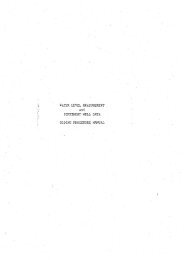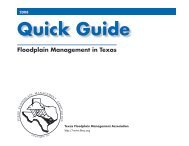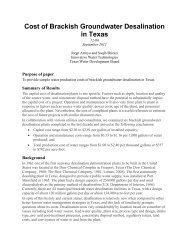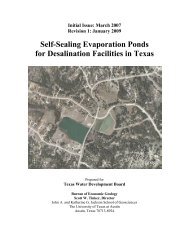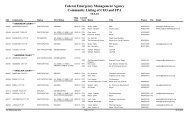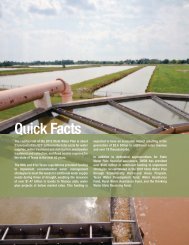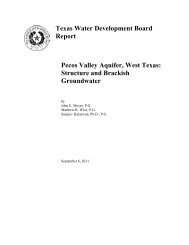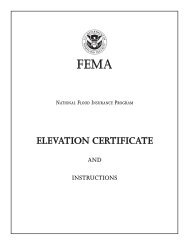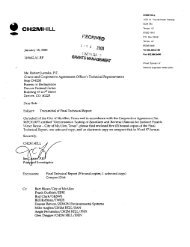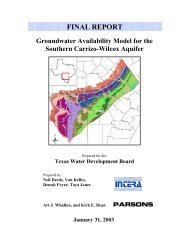Intensive Survey of the Guadalupe River Segment 1806
Intensive Survey of the Guadalupe River Segment 1806
Intensive Survey of the Guadalupe River Segment 1806
Create successful ePaper yourself
Turn your PDF publications into a flip-book with our unique Google optimized e-Paper software.
consideration. An abundance <strong>of</strong> orthophosphorus, a principle ingredient <strong>of</strong><br />
household detergents, in <strong>the</strong> water can be an indicator <strong>of</strong> recent sewage<br />
pollution. Chlorophyll a analyses may be utilized to provide an estimate <strong>of</strong><br />
<strong>the</strong> relative planktonic algal standing crops that were present at <strong>the</strong><br />
<strong>Guadalupe</strong> <strong>River</strong> sampling stations during <strong>the</strong> study period.<br />
As mentioned previously ammonia and nitrite nitrogen levels were very low<br />
through <strong>Segment</strong> <strong>1806</strong>. Nitrate nitrogen also occurred in low concentrations<br />
(< 0.25 mg/L) at <strong>the</strong> mainstream stations (Table 9). The source <strong>of</strong> nitrate<br />
nitrogen in <strong>the</strong> <strong>Guadalupe</strong> <strong>River</strong> may be spring sources from <strong>the</strong> Edwards<br />
Aquifer which has moderate levels (TWOB, 1977). Ortho and total<br />
phosphorus (TP) were also very low (< 0.04 mg/L) through <strong>the</strong> segment.<br />
These low levels suggest that nitrogen and phosphorus may be limiting to <strong>the</strong><br />
aquatic plant communities in <strong>the</strong> river depending on <strong>the</strong> time <strong>of</strong> <strong>the</strong> year.<br />
Chlorophyll a levels were also low (< 4 yg/L) through <strong>Segment</strong> <strong>1806</strong> (Table<br />
9). Chlorophyll a levels were not detected in five <strong>of</strong> seven samples collected<br />
at <strong>the</strong> mainstream stations. These data indicate that planktonic algal<br />
productivity in <strong>the</strong> <strong>Guadalupe</strong> <strong>River</strong> during <strong>the</strong> study was low.<br />
Chloride, Sulfate, and Total Dissolved Solids<br />
All <strong>of</strong> <strong>the</strong> sulfate and total dissolved solids levels at <strong>the</strong> mainstream stations<br />
were less than <strong>the</strong> respective segment criteria (40 mg/L and 400 mg/L, annual<br />
averages) (Table 9). All but one chloride level (49 mg/L at Station J,<br />
downstream <strong>of</strong> Flat Rock Dam), were less than <strong>the</strong> 40 mg/L annual average<br />
criterion. Levels for all three parameters exhibited general downstream trend<br />
toward increasing concentrations.<br />
Fecal Coliform Bacteria<br />
Fecal coliform levels were generally low through <strong>Segment</strong> <strong>1806</strong> <strong>of</strong> <strong>the</strong><br />
<strong>Guadalupe</strong> <strong>River</strong> (Table 10). Fecal coliform levels ranged from 6/100 mL<br />
downstream <strong>of</strong> Flat Rock Dam (Station J) to 142/100 mL at <strong>the</strong> county road<br />
upstream <strong>of</strong> SH 87. All <strong>of</strong> <strong>the</strong> levels were less than <strong>the</strong> 200/100 mL segment<br />
criterion.<br />
Benthic Macroinvertebrates<br />
To assess biological health in <strong>the</strong> study reach, benthic macroinvertebrates<br />
were collected at four riverine and three reservoir stations. A total <strong>of</strong> 114<br />
species was collected, including 88 from <strong>the</strong> river and 39 from <strong>the</strong> reservoir<br />
(Table 11). The high total reflects <strong>the</strong> general prevalence <strong>of</strong> stable<br />
environmental conditions.<br />
Near Station B, a riverine site located 0.2 m below Ingram Lake Dam, species<br />
richness was <strong>the</strong> highest in <strong>the</strong> study, and diversity and equitability values<br />
were well within ranges considered indicative <strong>of</strong> clean water. Sensitive<br />
10




